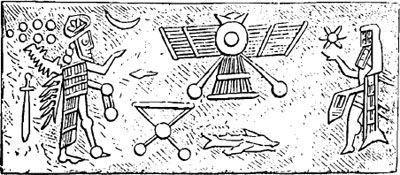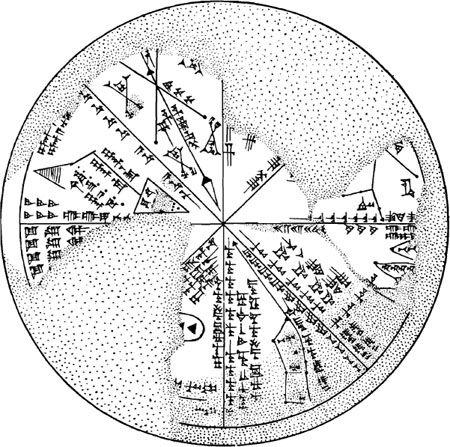The 12th Planet (43 page)
Authors: Zecharia Sitchin
Tags: #Non-Fiction, #Gnostic Dementia, #Fringe Science, #Retail, #Archaeology, #Ancient Aliens, #History

Next to Shupa was IRU ("loop"). At
Neptune,
the spacecraft of the Nefilim probably commenced its wide curve or "loop" toward its final target. Another list named the planet
H
UM.BA, which connotes "swampland vegetation." When we probe Neptune someday, will we discover that its persistent association with waters is due to the watery swamps the Nefilim saw upon it?
Uranus
was called
Kakkab Shanamma
("planet which is the double"). Uranus is truly the twin of Neptune in size and appearance. A Sumerian list calls it EN.TI.MASH.SIG ("planet of bright greenish life"). Is Uranus, too, a planet on which swampy vegetation abounded?
Beyond Uranus looms
Saturn,
a giant planet (nearly ten times Earth's size) distinguished by its rings, which extend more than twice as far out as the planet's diameter. Armed with a tremendous gravitational pull and the mysterious rings, Saturn must have posed many dangers to the Nefilim and their spacecraft. This may well explain why they called the fourth planet TAR.GALLU ("the great destroyer"). The planet was also called KAK.SI.DI ("weapon of righteousness") and SI.MUTU ("he who for justice kills"). Throughout the ancient Near East, the planet represented the punisher of the unjust. Were these names expressions of fear or references to actual space accidents?
The
Akitll
rituals, we have seen, made reference to "storms of the waters" between
An
and
Ki
on the fourth day—when the spacecraft was between
Anshar
(Saturn) and
Kishar
(Jupiter).
A very early Sumerian text, assumed since its first publication in 1912 to be "an ancient magical text," very possibly records the loss of a spaceship and its fifty occupants. It relates how Marduk, arriving at Eridu, rushed to his father Ea with some terrible news:
"It has been created like a weapon;
It has charged forward like death ...
The
Anunnaki
who are fifty,
it has smitten....
The flying, birdlike SHU.SAR
it has smitten on the breast."
The text does not identify "it," whatever destroyed the SHU.SAR (the flying "supreme chaser") and its fifty astronauts. But fear of celestial danger was evident only in regard to Saturn.
The Nefilim must have passed by Saturn and come in view of
Jupiter
with a great sense of relief. They called the fifth planet
Barharu
("bright one"), as well as SAG.ME.GAR ("great one, where the space suits are fastened"). Another name for Jupiter, SIB.ZI.AN.NA ("true guide in the heavens"), also described its probable role in the journey to Earth: It was the signal for curving into the difficult passage between Jupiter and Mars, and the entry into the dangerous zone of the asteroid belt. From the epithets, it would seem that it was at this point that the Nefilim put on their
mes,
their spacesuits.
Mars,
appropriately, was called UTU.KA.GAB.A ("light established at the gate of the waters"), reminding us of the Sumerian and biblical descriptions of the asteroid belt as the celestial "bracelet" separating the "upper waters" from the "lower waters" of the solar system. More precisely, Mars was referred to as
Shelibbu
("one near the center" of the solar system).
An unusual drawing on a cylinder seal suggests that, passing Mars, an incoming spacecraft of the Nefilim established constant communication with "Mission Control" on Earth. (Fig. 121)
The central object in this ancient drawing simulates the symbol of the Twelfth Planet, the Winged Globe. Yet it looks different: It is more mechanical, more manufactured than natural. Its "wings" look almost exactly like the solar panels with which American spacecraft are provided to convert the Sun's energy to electricity. The two antennas cannot be mistaken.
The circular craft, with its crownlike top and extended wings and antennas, is located in the heavens, between Mars (the six-pointed star) and Earth and its Moon. On Earth, a deity extends his hand in greeting to an astronaut still out in the heavens, near Mars. The astronaut is shown wearing a helmet with a visor and a breastplate. The lower part of his suit is like that of a "fish-man"—a requirement, perhaps, in case of an emergency splashdown in the ocean. In one hand he holds an instrument; the other hand reciprocates the greeting from Earth.

Fig. 121
And then, cruising on, there was
Earth,
the seventh planet. In the lists of the "Seven Celestial Gods" it was called SHU.GI ("right resting place of SHU"). It also meant the "land at the conclusion of SHU," of the Supreme Part of the solar system—the destination of the long space journey.
While in the ancient Near East the sound
gi
was sometimes transformed into the more familiar
ki
("Earth," "dry land"), the pronunciation and syllable
gi
have endured into our own times in their original meaning, exactly as the Nefilim meant it to be:
geo
-graphy,
geo-
metry,
geo
-logy.
In the earliest form of pictographic writing, the sign SHU.GI also meant
shibu ("the seventh").
And the astronomical texts explained:
Shar shadi il Enlil ana kakkab SHU.GI ikabbi
"Lord of Mountains, deity Enlil, with planet Shugi is identical."
Paralleling the seven stations of Marduk's journey, the planets' names also bespeak a space flight. The land at the journey's end was the seventh planet, Earth.
•
We may never know whether, countless years from now, someone on another planet will find and understand the message drawn on the plaque attached to
Pioneer 10.
Likewise, one would think it futile to expect to find on Earth such a plaque in reverse—a plaque conveying to Earthlings information regarding the location and the route from the Twelfth Planet.
Yet such extraordinary evidence does exist.
The evidence is a clay tablet found in the ruins of the Royal Library of Nineveh. Like many of the other tablets, it is undoubtedly an Assyrian copy of an earlier Sumerian tablet. Unlike others, it is a circular disc; and though some cuneiform signs on it are excellently preserved, the few scholars who took on the task of deciphering the tablet ended by calling it "the most puzzling Mesopotamian document."
In 1912, L. W. King, then curator of Assyrian and Babylonian antiquities in the British Museum, made a meticulous copy of the disc, which is divided into eight segments. The undamaged portions bear geometric shapes unseen on any other ancient artifact, designed and drawn with considerable precision. They include arrows, triangles, intersecting lines, and even an ellipse—a geometric-mathematical curve previously assumed to have been unknown in ancient times. (Fig. 122)
The unusual and puzzling clay plaque was first brought to the attention of the scientific community in a report submitted to the British Royal Astronomical Society on January 9, 1880. R. H. M. Bosanquet and A. H. Sayce, in one of the earliest discourses on "The Babylonian Astronomy," referred to it as a planisphere (the reproduction of a spherical surface as a flat map). They announced that some of the cuneiform signs on it "suggest measurements ... appear to bear some technical meaning."
The many names of celestial bodies appearing in the eight segments of the plaque clearly established its astronomical character. Bosanquet and Sayce were especially intrigued by the seven "dots" in one segment. They said these might represent the phases of the Moon, were it not for the fact that the dots appeared to run along a line naming the "star of stars" DIL.GAN and a celestial body called APIN.
"There can be no doubt that this enigmatical figure is susceptible of a simple explanation," they said. But their own effort to provide such an explanation did not go beyond reading correctly the phonetic values of the cuneiform signs and the conclusion that the disc was a celestial planisphere.
When the Royal Astronomical Society published a sketch of the planisphere, J. Oppert and P. Jensen improved the reading of some star or planet names. Dr. Fritz Hommel, writing in a German magazine in 1891 ("Die Astronomie der Alten Chaldäer"), drew attention to the fact that each one of the eight segments of the planisphere formed an angle of 45 degrees, from which he concluded that a total sweep of the skies—all 360 degrees of the heavens—was represented. He suggested that the focal point marked some location "in the Babylonian skies."

Fig. 122
There the matter rested until Ernst F. Weidner, first in an article published in 1912
(Babyloniaca:
"Zur Babylonischen Astronomie") and then in his major textbook
Handbuch der Babylonischen Astronomie
(1915), thoroughly analyzed the tablet, only to conclude that it did not make sense.
His bafflement was caused by the fact that while the geometric shapes and the names of stars or planets written within the various segments were legible or intelligible (even if their meaning or purpose was unclear), the inscriptions along the lines (running at 45-degree angles to each other) just did not make sense. They were, invariably, a series of repeated syllables in the tablet's Assyrian language. They ran, for example, thus:
lu bur di lu bur di lu bur di
bat bat bat kash kash kash kash alu alu alu alu
Weidner concluded that the plaque was both astronomical and astrological, used as a magical tablet for exorcism, like several other texts consisting of repeated syllables. With this, he laid to rest any further interest in the unique tablet.
But the tablet's inscriptions assume a completely different aspect if we try to read them not as Assyrian word-signs, but as Sumerian word-syllables; for there can hardly be any doubt that the tablet represents an Assyrian copy of an earlier Sumerian original. When we look at one of the segments (which we can number I), its meaningless syllables
na na na na a na a na nu
(along the descending line)
sha sha sha sha sha sha
(along the circumference)
sham sham bur kur Kur
(along the horizontal line)
literally spring to meaningfulness if we enter the Sumerian meaning of these word-syllables. (Fig. 123)
What unfolds here is a
route map,
marking the way by which the god Enlil "went by the planets," accompanied by some operating instructions. The line inclined at 45 degrees appears to indicate the line of a spaceship's descent from a point which is "high high high high," through "vapor clouds" and a lower zone that is vaporless, toward the horizon point, where the skies and the ground meet.
